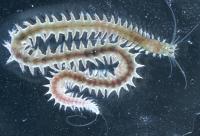
Platynereis dumerilii, a marine bristle worm, is becoming a new model for studying early stages of cell development. University of Oregon biologists studying a common ocean-dwelling worm have uncovered potentially fundamental insights into the evolutionary origin of genetic mechanisms, which when compromised in humans play a role in many forms of cancer.
Their research, appearing in the July issue of the journal Developmental Cell, also increases the visibility of a three-year effort at the UO to promote use of the bristle worm Platynereis dumerilii as a model organism for the study of evolutionary origins of cell types and animal forms.
The marine worm develops by a stereotypic pattern of asymmetric cell divisions generating differently sized embryonic cells. Platynereis dumerilii, the researchers wrote, “appears to have retained ancestral morphological and genomic features, including a slowly evolving protein complement,” and, therefore, can be considered a living fossil.
“Our studies of this organism, called a polychaete annelid, a marine relative of earthworms, have provided potentially fundamental insights into the evolutionary origin of the genetic mechanisms that determine how different cell types are produced during animal embryogenesis,” said lead author Stephan Q. Schneider, a postdoctoral researcher in the UO Institute of Molecular Biology.
The genetic mechanism, in this case, is the beta-catenin signaling pathway and its regulation after cell divisions. Beta-catenin is a cellular protein, which regulates cell proliferation and communication between cells.
“This ancient mechanism remains a central feature of animal development in all animals today, and malfunction of this mechanism in humans is associated with some of the most common and deadly forms of cancer, including colon cancer and melanoma,” Schneider said.
Schneider and co-author Bruce Bowerman, a professor of molecular biology, identified a highly conserved beta-catenin in this ancient worm and documented the protein’s subcellular accumulation in 390 cells produced during the division of fertilized eggs during 195 separate embryonic cell cycles. __IMAGE_2
Surprisingly, they said, they found an accumulation of beta-catenin in only one of the two daughter cells after each cell division. They showed that the regulation of beta-catenin accumulation forms a molecular switch between two new daughter cells, causing the cells to be different from one another. This universal mechanism operates in embryos as a binary decision-maker, creating an organism with a diversity of cell types.
Beta-catenin has been the focus of research in other model systems, such as mice, fruit flies and roundworms, but never in these ancient slowly evolving invertebrates used in the UO research. The protein appears to be conserved throughout the animal kingdom.
In humans suffering from a variety of cancers, a breakdown in the normal regulation of beta-catenin signaling is thought to be responsible for the growth of related tumors. Coupled with similar findings involving beta-catenin in the nematode Caenorhabditis elegans, a roundworm found in soil, the new UO report suggests an ancient metazoan origin and role for beta-catenin protein in the earliest stages of cellular development.
The findings, Bowerman said, suggest that the genetic pathway in the marine worm may be one of the earliest mechanisms used in embryogenesis to make cells adopt different roles during development. The worms used in the UO study originated from the Mediterranean.
“It is intriguing that key components of the widely conserved beta-catenin cell-signaling pathway appear to specify cell fate throughout development in an embryo that, given the invariance of the embryonic cell lineage and the prevalence of asymmetric cell divisions, has been viewed as a classic example of mosaic development,” Schneider and Bowerman wrote in their conclusion.
There are some 10,000 species of polychaete annelids, dating back to the Paleozoic era, which started 542 million years ago. Polychaete refers to “many hairs” or “many bristles” that come off protrusions of the worms’ bodies, which consist of fluid-filled tubes within tubes. These worms are bilaterally symmetrical with closed circulatory systems. Their ancient simplicity, Bowerman said, makes the Platynereis a rather uncomplicated model system for studying such protein interactions. Source : University of Oregon
 Print Article
Print Article Mail to a Friend
Mail to a Friend
